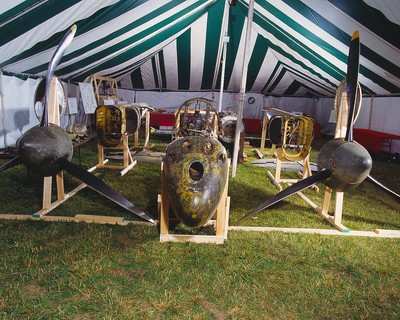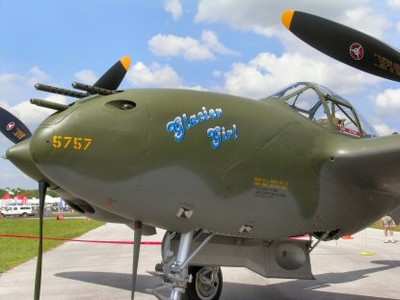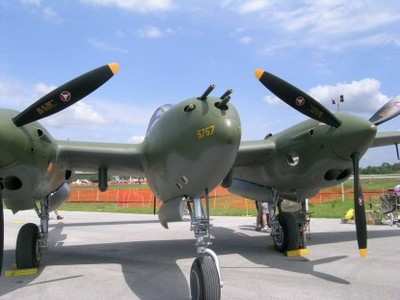 A Lockheed P-38 Lightning named
"Glacier Girl," the subject of one of the world's most intriguing
aircraft recovery stories, will return to Oshkosh this summer
to mark the 60th anniversary of the end of World War II. The
53rd annual EAA AirVenture gathering, the world's greatest aviation
celebration, is July 25-31 at Wittman Regional Airport in Oshkosh,
Wis.
A Lockheed P-38 Lightning named
"Glacier Girl," the subject of one of the world's most intriguing
aircraft recovery stories, will return to Oshkosh this summer
to mark the 60th anniversary of the end of World War II. The
53rd annual EAA AirVenture gathering, the world's greatest aviation
celebration, is July 25-31 at Wittman Regional Airport in Oshkosh,
Wis.
The P-38 will fly to EAA AirVenture 13 years after its first
appearance at the EAA event. In 1992, the airplane was
nothing more than a collection of aircraft parts that had just been
rescued from under the Greenland ice cap after 50 years. The
recovery team that extracted the parts from below more than 250
feet of ice and brought the parts to display at Oshkosh even before
taking them home to begin the decade-long aircraft restoration.
"We are absolutely thrilled to welcome Glacier Girl back to
Oshkosh as a fully airworthy P-38 this year, because the aircraft
has always held a special place for EAA members," said Tom
Poberezny, EAA president and AirVenture chairman. "When the
P-38 parts were first brought here in 1992 (shown below), it was a
high point of that year's EAA fly-in. Since then, a recurring
annual question has been, 'Will we see it at Oshkosh this
year?' Glacier Girl's participation, along with the other rare
World War II aircraft already confirmed, will truly make EAA
AirVenture 2005 an unmatched spectacle."

Glacier Girl will be on display throughout the weeklong EAA
AirVenture event and will be parked on the main showcase AeroShell
Square. The aircraft will also participate in warbirds flying
activities during the spectacular air shows celebrating the 60th
anniversary of the end of World War II.
This P-38 was originally part of "Operation Bolero," a massive
buildup of U.S. warplanes in Great Britain in 1942. Enroute to
Europe, it and several other aircraft were forced to ditch on the
ice. Beginning in the early 1980s, several people had
considered rescuing at least one of the ditched aircraft, but
simply finding the airplanes under the massive ice buildup proved
daunting. After discovering this aircraft, the recovery teams
drilled down more than 250 feet and created an ice cave to bring
the P-38 airframe to the surface.

After several delays slowed the reconstruction process, Kentucky
resident J. Roy Shoffner eventually became sole owner of the
project and dedicated his effort to complete the P-38's
rebirth. After a meticulous, 10-year restoration, Glacier Girl
was flown for the first time on October 26, 2002. The P-38 is
currently housed at the Lost Squadron Museum in Middlesboro,
Kentucky.
"For the past 13 years, we've been hearing from people who say,
'We saw the airplane back in 1992 at Oshkosh when all the parts
came there in a DC-3,' so this is a very big appearance for us."
said Bob Cardin of the Lost Squadron Museum, who has been with the
airplane since the recovery effort began.

"This is our way of thanking everyone for their support of the
project. If you're going to go someplace with the airplane,
there's no better place than Oshkosh, because it's the mecca for
aviation."
The Lockheed P-38 Lightning was developed in the late 1930s and
first delivered to the U.S. Army Air Corps in 1941. In its
time, it was the fastest aircraft in the American military, with a
top speed of more than 400 miles per hour. It is also
visually memorable, with its twin engines and twin tail booms
earning it the nickname "Fork-tailed Devil" among enemy forces in
the Pacific Theater. Of the more than 10,000 P-38s built, fewer
than 10 remain airworthy today.

The EAA AirVenture Museum has featured a P-38 as part of its
Eagle Hangar display for more than 15 years. That particular
airplane is painted in the colors of Maj. Richard Bong, a northern
Wisconsin farm boy who became America's all-time aerial ace during
World War II with 40 air victories.
 ANN's Daily Aero-Term (05.01.24): Say Altitude
ANN's Daily Aero-Term (05.01.24): Say Altitude ANN's Daily Aero-Linx (05.01.24)
ANN's Daily Aero-Linx (05.01.24) Classic Aero-TV: Korean War Hero Twice Reborn
Classic Aero-TV: Korean War Hero Twice Reborn Airborne 04.29.24: EAA B-25 Rides, Textron 2024, G700 Deliveries
Airborne 04.29.24: EAA B-25 Rides, Textron 2024, G700 Deliveries Airborne Affordable Flyers 05.02.24: Bobby Bailey, SPRG Report Cards, Skydive!
Airborne Affordable Flyers 05.02.24: Bobby Bailey, SPRG Report Cards, Skydive!







